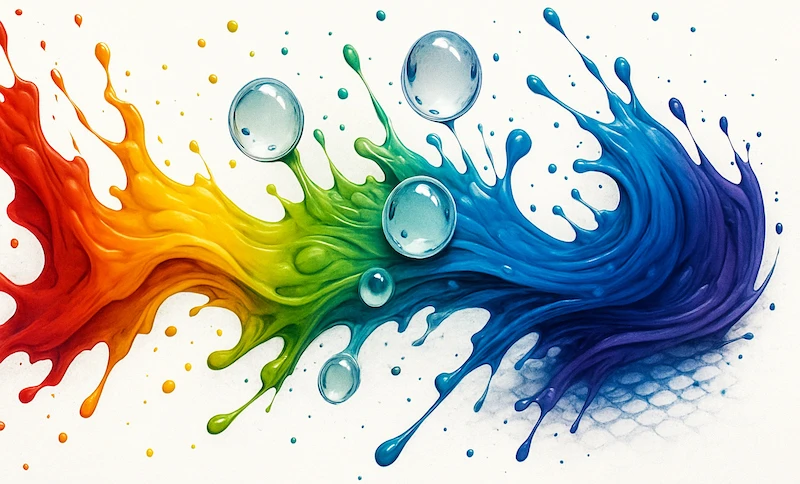You expect sublimation prints to come out crisp, sharp, and vibrant — but sometimes the results look dull, blurry, or washed out. One of the most overlooked reasons isn’t your printer, ink, or settings. It’s moisture!
Moisture can be absorbed by sublimation paper, polyester substrates, and even the ink itself. When the press heats up, trapped moisture flashes into steam and interferes with the transfer of dye vapor into polyester fibers. Even a tiny amount of humidity can cause color fading, fuzzy details, or ghosting.
How Moisture Causes Blurry or Dull Sublimation PrintsMoisture trapped in sublimation paper or polyester creates steam when heated. This steam disrupts dye vapor flow, causing incomplete sublimation. The dye can’t fully gas into the fibers, leading to faded colors, blotchy areas, or ghosting. Pre-press conditioning removes this moisture so dye vapor transfers smoothly and consistently into polyester, resulting in sharp details and vibrant saturation.

Pre-press conditioning, whether by pre-pressing the substrate or storing your paper in a low-humidity environment, drives off excess moisture so the sublimation dye has a clean path from paper → gas → polyester.
- Moisture Interferes With Dye Vaporization During Sublimation
- High Humidity Leads to Dull, Desaturated, or Faded Prints
- Excess Moisture Causes Ghosting and Unwanted Shadow Effects
- Pre-Press Conditioning Eliminates Moisture and Prevents Transfer Defects
- Sublimation Paper Naturally Absorbs Humidity and Must Be Properly Stored
Key Takeaways
Moisture disrupts dye vaporization.
When moisture turns to steam under heat, it blocks dye gas from penetrating polyester fibers.
Humidity causes dull or faded prints.
Dye vapor scatters when moisture escapes, reducing color saturation and vibrancy.
Moisture creates “ghosting”.
Excess steam pushes dye in unintended directions, causing soft shadows around your design.
Pre-press conditioning prevents moisture defects.
Pre-pressing or warming the substrate removes trapped moisture before printing.
Sublimation paper absorbs humidity.
Store paper sealed and flat — moisture usually enters the paper, not the ink.
Moisture Interferes With Dye Vaporization During Sublimation
Moisture is one of the biggest obstacles to clean sublimation because even a small amount disrupts the dye vaporization process.When moisture is present, it heats rapidly and becomes steam, causing vapor flow disruption and blocking the path of the dye when in the process of converting into gas.
This leads to vapor blockage, uneven gas-phase dye movement, and a drop in overall sublimation reaction efficiency. Instead of smooth dye diffusion, the steam causes turbulence, redirecting or slowing the dye as it tries to migrate into the substrate. The result is ink vaporization failure, partial transfer, or inconsistent color penetration.
In severe cases, moisture contamination causes the dye to migrate unpredictably, a problem often referred to as dye migration or steam interference. When the dye cannot complete a clean heat-activated ink conversion, colors appear muted, soft, or blotchy.
Effective moisture control ensures stable sublimation gas transfer, preventing vapor disruption and allowing the dye to enter polyester fibers with maximum accuracy and consistency.
High Humidity Leads to Dull, Desaturated, or Faded Prints
High humidity directly affects color accuracy in sublimation by altering how the dye settles into polyester fibers. When the substrate or paper absorbs excess moisture, the dye cannot anchor evenly, leading to color desaturation and reduced vibrancy. This shows up as washed-out colors, muted tones, and overall faded image quality.
Humidity also causes uneven color output, where certain areas hold more moisture than others. These pockets of moisture create inconsistent dye penetration, resulting in visible color inconsistency across the print. Instead of a uniform image, you get patches of ink dulling or loss of color depth.
Because the dye cannot bond efficiently under humid conditions, you experience print fading immediately after pressing, not over time. This happens when the dye fails to make a complete, even transition into the polyester, producing suboptimal color transfer.
Controlling humidity ensures stable color density, predictable saturation, and consistent vibrancy throughout the entire print surface.
Excess Moisture Causes Ghosting and Unwanted Shadow Effects
When moisture remains in the paper or substrate during pressing, it expands rapidly and forces the dye to move unpredictably. This creates image ghosting, where a faint duplicate of the design appears beside the main transfer. The result is visible shadowing artifacts or a subtle double-image effect that reduces overall print clarity. While this type of ghosting is caused by moisture, other forms can appear even when the substrate is dry, many of which are outlined in my ghosting in sublimation printing guide and occur for entirely different reasons.
Moisture-driven movement causes ink drift and dye misplacement, where the dye shifts slightly before bonding to the polyester. This moisture-induced shifting leads to blurry edges and outlines that don’t match the original artwork. The escaping steam can push dye outward, forming shadow halos or light rings around detailed areas.
In more severe cases, the moisture creates unintended dye spread, where the dye lifts and repositions due to steam-driven movement inside the press. This can create a partial secondary image imprint, especially around text, logos, and fine lines.
| 💡 What’s the Difference Between Ghosting & Secondary Image Imprint?Ghosting and secondary image imprints differ mainly in how clearly they repeat the design. Ghosting appears as a faint, clean duplicate that sits close to the original, essentially a soft shadow or lightly offset outline. Secondary image imprints, however, look more irregular. Instead of a neat duplicate, they show up as blotchy patches, streaks, or partial repeats. |
Controlling moisture prevents this unwanted movement, ensuring sharp edges, clean outlines, and accurate image placement.
Pre-Press Conditioning Eliminates Moisture and Prevents Transfer Defects
Pre-press conditioning focuses on moisture removal before any sublimation transfer begins. By applying a short pre-heating or pre-pressing step, you warm the substrate just enough to release trapped moisture without starting the transfer process. This early heat preparation acts as a controlled drying cycle, ensuring the surface is stable and ready for accurate dye bonding.
| 💡 How Long Should You Pre-Press to Remove Moisture?There’s no universal pre-press time because materials retain moisture differently, but most polyester substrates only need a short pre-press of 3–10 seconds at a temperature slightly below your full transfer setting. The goal is simply to warm the material enough to release trapped moisture, not trigger sublimation. You’ll know the substrate is ready once steam stops escaping within the first few seconds and the surface feels evenly warm and dry. |
Effective substrate conditioning is a form of preventative moisture control, reducing the risk of defects that occur when water flashes into steam during pressing. Techniques such as brief pre-press treatments, light warming, or controlled humidity reduction in storage environments all contribute to a cleaner, moisture-free transfer.
These press preparation techniques help stabilize temperature, minimize moisture variability, and support consistent moisture mitigation across different materials. With proper pre-press conditioning, the substrate reaches the press in a dry, predictable state, allowing the dye to bond cleanly and reducing the likelihood of any transfer-related issues.
Sublimation Paper Naturally Absorbs Humidity and Must Be Properly Stored
Sublimation paper is intentionally engineered with a porous, absorbent coating that holds and releases dye, but this also makes it quick to take in environmental humidity. This paper moisture uptake affects how the dye releases during pressing. When the fibers absorb excess water, the sheet can soften or curl, leading to paper warping or softening that compromises alignment and transfer accuracy.
Proper paper conditioning and storage humidity control are essential to keep the paper stable. Storing it flat, sealed, and in controlled-environment storage reduces humidity absorption and prevents moisture from settling into the paper fibers. Because sublimation paper is a moisture-prone media, maintaining consistent dry storage practices ensures predictable dye release and minimizes the risk of transfer defects.
Keeping the paper dry protects the integrity of paper fiber absorption, allowing the dye to transfer cleanly and consistently when heat is applied.
Related Topics
